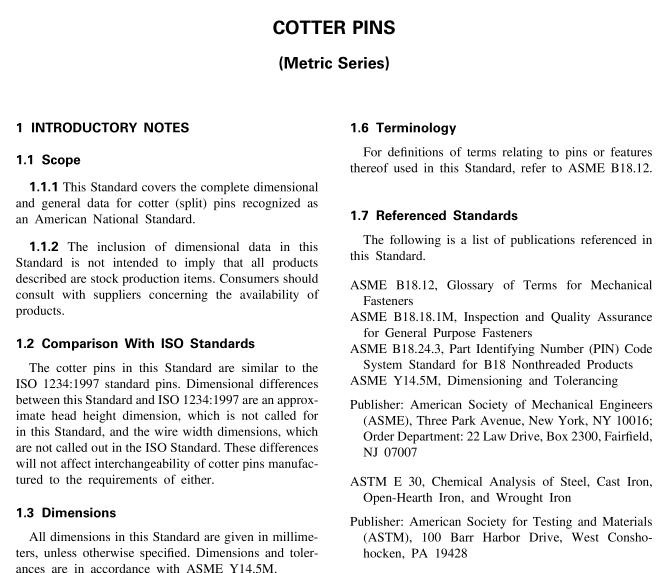ASME B18-8-200M pdf download

ASME B18-8-200M pdf download COTTER PINS, HEADLESS CLEVIS PINS, AND HEADED CLEVIS PINS (METRIC SERIES)
2.2 Head Design
A degree of leeway shall be permissible in the designof the head provided; however,the minimum outsidediameter is maintained as specified in Table 2.
2.3 Length
2.3.1 Measurement. The length of pin,L, shallbe measured,parallel to the axis of the pin,from theplane of contact of a gage with the head of the pinto the end of the prong or pin as depicted in theillustrations for the respective point types (see Fig. 1).The gage shall have a hole equal to the specified gagehole diameter within a tolerance of :0.03 mm (seeTable 2). The permissible break or rounding at thegaging edges of gaging holes shall not exceed 0.13mm.The pin shall be inserted into the gage with fingerpressure (force not to exceed 2.2 N).
Where pins having point types other than thoseillustrated herein are gaged,the length,L, shall bemeasured from the plane of contact of the gage withthe end of the shortest prong.
2.3.2 Tolerance on Length. The tolerance onlength of cotter pins shall be as specified in Table 1.2.3.3 Preferred Lengths. Table 3 depicts the pre-ferred sizes and lengths of pins that are normallyavailable. Other sizes and lengths are produced,asrequired by the purchaser.
2.4 Prongs
2.4.1 Preferred Points. The preferred point typeshall be the extended prong – square cut or hammerlock design illustrated, as specified by the purchaser.Variations of the extended prong design and other types
of points are also available, subject to mutual agreementbetween the purchaser and manufacturer.
2.4.2 Prong Alignment. The ends of the pinsshall not be open,and any gaps occurring between theprongs along the shank portion of pins beyond the endshall not exceed to 0.4 mm for pins 8 mm and over.The misalignment of prongs over the entire length ofthe shank shall not stop the pin from being insertedinto the gaging hole.
2.5 Material and Test
2.5.1 Material. Low carbon steel shall be usedunless otherwise specified as agreed upon between themanufacturer and purchaser.
2.5.2 Analysis. Chemical composition determina-tions shall be made in accordance with methods given inASTM E 30 when composition verification is specified.2.5.3 Ductility. Each prong of the cotter pin shallbe capable of withstanding being bent back upon itselfonce with no visible indication of fracture occurringat the point of bend.
2.5.4 Wire Section. Cotter pins are manufacturedfrom approximately half-round wire, and it is desirable
that the flat side of the wire have a small degree ofrounding at the edges rather than sharp corners.
2.6 Finish
Unless otherwise specified by the purchaser,cotterpins shall be supplied with a plain (as processed) finish,not plated or coated. Other finishes,where required,
shall be subject to agreement between the manufacturerand purchaser.
2.7 Workmanship
Cotter pins shall be free from excessive burrs,cracks,loose scale, sharp edges,and all other defects affectingtheir serviceability.









